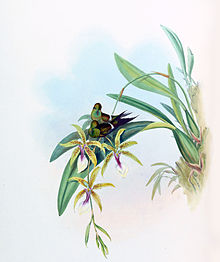
Letitia's thorntail

| Letitia's thorntail | |
|---|---|

| |
| Illustration by John Gould | |
| Scientific classification | |
| Domain: | Eukaryota |
| Kingdom: | Animalia |
| Phylum: | Chordata |
| Class: | Aves |
| Clade: | Strisores |
| Order: | Apodiformes |
| Family: | Trochilidae |
| Genus: | Discosura |
| Species: | D. letitiae
|
| Binomial name | |
| Discosura letitiae | |
| Synonyms | |
|
Popelairia letitiae (Bourcier & Mulsant, 1852) | |
Letitia's thorntail (Discosura letitiae), also known as the coppery thorntail, is a very poorly known species of hummingbird in the "coquettes" tribe Lesbiini of subfamily Lesbiinae.[3][4] It was named after Letizia del Gallo Roccagiovine (1848–1863), granddaughter of the ornithologist Charles Bonaparte. [5]

Taxonomy and systematics
Letitia's thorntail is only known from two old male specimens described as from Bolivia. Localities for old skins often are unreliable, and it is possible they came from elsewhere. Consequently, its behavior and habitat are unknown but are likely similar to those of other thorntails. It has been suggested that it represented a hybrid or a variant of the racquet-tailed coquette, but a study by G.R. Graves has supported its status as a distinct species. Graves suggested the English name of Letitia's coquette because the specimens' tail feathers more closely resemble those of coquettes than those of thorntails.[6]

Description
Graves described the specimens of Letitia's thorntail, but noted that the perceived colors of hummingbirds depend on the lighting and the observer's angle of view. The crown is brilliant golden-green that blends to dark bronze-green on the back with some coppery-bronze iridescence. The lower back is crossed by a narrow white band below which is a coppery red to coppery purple rump and bronze-green uppertail coverts. The chin and upper breast are golden-green like the crown with a diffuse pale pectoral band below the latter. The midline of the lower breast is bronze-green with coppery red spangles. The lower belly and flanks are buffy- to grayish white, the vent is dark gray, and the undertail coverts dark green with rufous tips. One specimen lacks the central tail feathers; the other specimen's are bronze-green with broad black tips. The other tail feathers are brownish black. The tail feathers are progressively longer from the innermost to the outermost but the outermost are not as dramatically longer as in other thorntails.[6]

Status
The IUCN has assessed Letitia's thorntail as Data Deficient.[1] Its "distribution [is] uncertain due to doubts over provenance of specimens" so it is possible that the species still exists undetected elsewhere than Bolivia.[7]

References
- ^ a b BirdLife International (2016). "Coppery Thorntail Discosura letitiae". IUCN Red List of Threatened Species. 2016: e.T22687265A93146232. doi:10.2305/IUCN.UK.2016-3.RLTS.T22687265A93146232.en. Retrieved 24 January 2022.
- ^ "Appendices | CITES". cites.org. Retrieved 2022-01-14.
- ^ Gill, F.; Donsker, D.; Rasmussen, P., eds. (January 2022). "Hummingbirds". IOC World Bird List. v 12.1. Retrieved January 15, 2022.
- ^ HBW and BirdLife International (2020) Handbook of the Birds of the World and BirdLife International digital checklist of the birds of the world Version 5. Available at: http://datazone.birdlife.org/userfiles/file/Species/Taxonomy/HBW-BirdLife_Checklist_v5_Dec20.zip [.xls zipped 1 MB] retrieved May 27, 2021
- ^ Beolens, Bo; Watkins, Michael; Grayson, Michael (2014). The Eponym Dictionary of Birds (1. Aufl ed.). London u.a: Bloomsbury Publ. ISBN 978-1-4729-0573-4.
- ^ a b Graves, G.R. (1999). "Taxonomic notes on hummingbirds (Aves: Trochilidae) 2. Popelairia letitiae (Bourcier & Mulsant, 1852) is a valid species". Proceedings of the Biological Society of Washington. 112 (4): 804–812. Retrieved January 24, 2022.
- ^ Züchner, T., P. F. D. Boesman, and C. J. Sharpe (2020). Coppery Thorntail (Discosura letitiae), version 1.0. In Birds of the World (J. del Hoyo, A. Elliott, J. Sargatal, D. A. Christie, and E. de Juana, Editors). Cornell Lab of Ornithology, Ithaca, NY, USA. https://doi.org/10.2173/bow.coptho2.01 retrieved January 24, 2022
See what we do next...
OR
By submitting your email or phone number, you're giving mschf permission to send you email and/or recurring marketing texts. Data rates may apply. Text stop to cancel, help for help.
Success: You're subscribed now !

